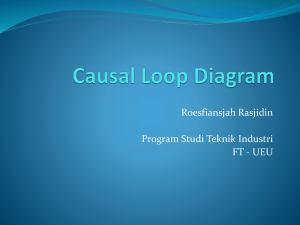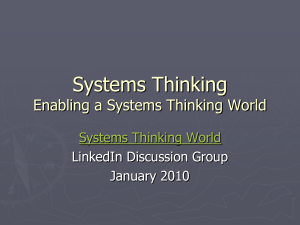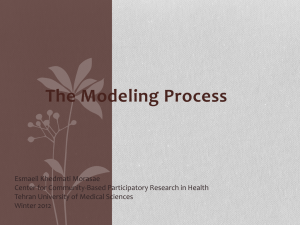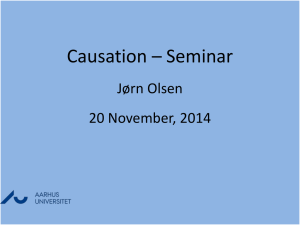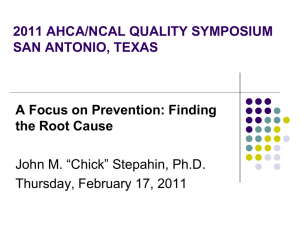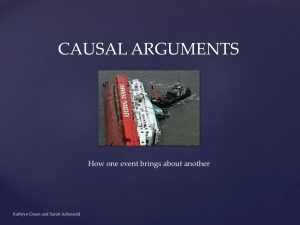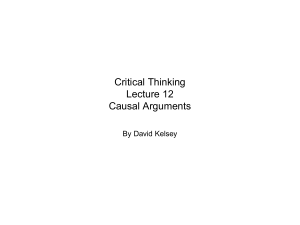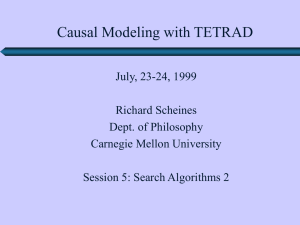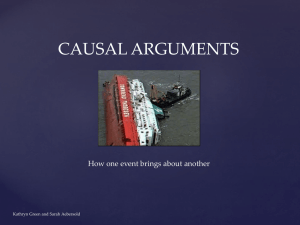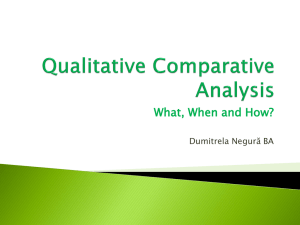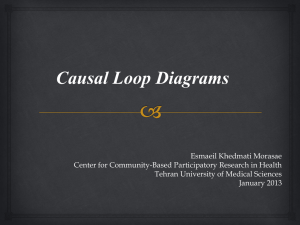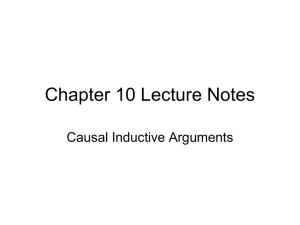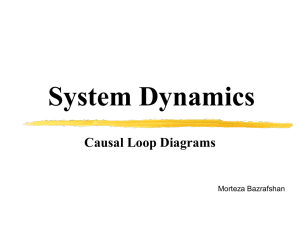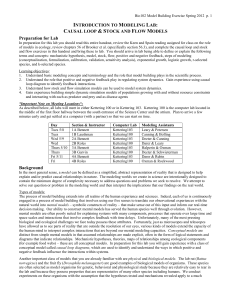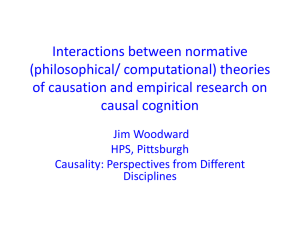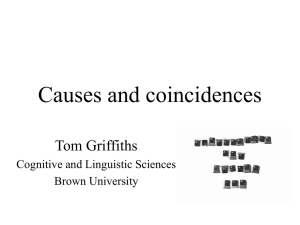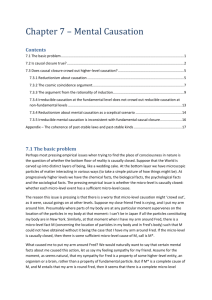SD in Practice - a Systems Perspective on Change
advertisement
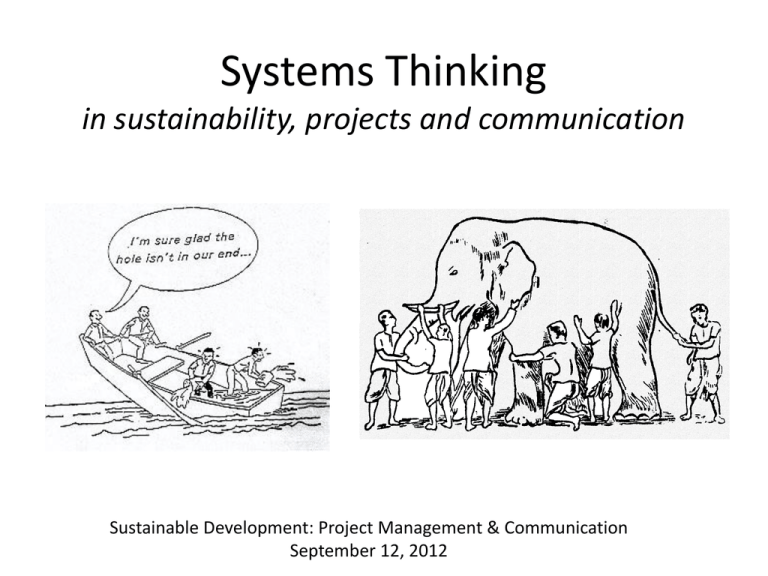
Systems Thinking in sustainability, projects and communication Sustainable Development: Project Management & Communication September 12, 2012 Systems Thinking Systems thinking is the process of understanding how things influence one another within a whole. (Wikipedia) Systems thinking is a way of understanding reality that emphasizes the relationships among a system's parts, rather than the parts themselves. (Pegasus Commnunications) Intuition & Analysis Right brain & Left brain Complexity & Simplicity Structure & Behavior System a set of things – people, cells, molecules, or whatever – interconnected in such a way that they produce their own pattern or behavior over time. (Meadows, 2008) a group of interacting, interrelated, and interdependent components that form a complex and unified whole. (Pegasus Communications) an entity which maintains its existence through the mutual interaction of its parts. (www.systems-thinking.org) Aim Using systems thinking to manage and communicate projects that contribute to a sustainable development System 1610s, "the whole creation, the universe," from L.L. systema "an arrangement, system," from Gk. systema "organized whole, body," Think O.E. þencan "conceive in the mind, think, consider, intend" (past tense þohte, p.p. geþoht), probably originally "cause to appear to oneself," Sustainable 1610s, "bearable," from sustain + -able. Attested from 1845 in the sense "defensible;" from 1965 with the meaning "capable of being continued at a certain level." Development 1756, "an unfolding;" see develop + -ment. Of property, with the sense "bringing out the latent possibilities," from 1885. Meaning "state of economic advancement" is from 1902. Meaning "advancement through progressive stages" is 1836. Project c.1400, "a plan, draft, scheme," from L. projectum "something thrown forth," noun use of neuter of projectus, pp. of projicere "stretch out, throw forth," from pro- "forward" (see pro-) + combining form of iacere (pp. iactus) "to throw" (see jet (v.)). Meaning "scheme, proposal, mental plan" is from c.1600. Manage 1560s, probably from It. maneggiare "to handle," especially "to control a horse," ultimately from Latin noun manus "hand" (seemanual (adj.)). Influenced by Fr. manège "horsemanship" (earliest English sense was of handling horses), which also was from Italian. Extended to other objects or business from 1570s. Communication late 14c., from O.Fr. comunicacion (14c., Mod.Fr. communication), from L. communicationem (nom. communicatio), noun of action from communicare "to share, divide out; communicate, impart, inform; join, unite, participate in," lit. "to make common," fromcommunis (see common) Aim - rephrased Causing organized whole bodies to appear to oneself, in order to handle, and make common, something thrown forth that contributes to a bearable unfolding. Exercise: Paper Tear Ways of explaining reality Ways of explaining reality Ways of explaining reality Events Patterns, Trends Systemic Structures Mental Models What just happened? What’s been happening? Have we been here or some place similar before? What are the forces at play contributing to these patterns? What about our thinking allows this situation to persist? Ways of explaining reality Drought Events Declining Water Table Patterns, Trends B3 Water from Pumping + Systemic Structures - Water Demand + Irrigated + Lands - External Water Resources B1 B4 + Expand if Water Available + + Natural Vegetation + Water from Divertions Divertions + Water Supply Unit Cost - B6 Salinization of + Aquifers Water Supply Expectations Drive Irrigation Development + + Piezometric Levels Seawater Intrusion Costs Escalation Expected Profitability Dams + + B2 R6 B5 Water from Reservoirs + Expand if Land Available + + - Water in Local Aquifers Surface Water Availability + Profitability + from Irrigated Lands Available Area for New Irrigated Lands Mental Models Pumping Water Excess/Shortage + + Planned Increase of Water Resources Pressure for more Water • One cause produces one effect. There must be a single cause, for example, of acid rain, or cancer, or the greenhouse effect. All we need to do is discover and remove it. • All growth is good—and possible. There are no effective limits to growth. • Technology can solve any problem that comes up. • The future is to be predicted, not chosen or created. It happens to us; we do not shape it. • A problem does not exist or is not serious until it can be measured. Mental Models – Patterns of Thought ”Without changing our patterns of thought, we will not be able to solve the problems we created with our patterns of thought” Albert Einstein ”Our life is what our thoughts make it” Marcus Aurelius, Meditations Color Furniture Tool ISIS INDICATORS (I) Definition An indicator quantifies and simplifies phenomena and helps us understand complex realities. Indicators are aggregates of raw and processed data but they can be further aggregated to form complex indices. (International Institute for sustainable development) An indicator can be defined as something that helps us to understand where we are, where we are going and how far we are from the goal. Therefore it can be a sign, a number, a graphic and so on. It must be a clue, a symptom, a pointer to something that is changing. Indicators are presentations of measurements. They are bits of information that summarize the characteristics of systems or highlight what is happening in a system. To interpret indicators Ideal OK Collapse past present WHAT SYSTEM? • • • • • • Sweden Uppsala Uppsala University The Geosciences building CEMUS Other? System a set of things – people, cells, molecules, or whatever – interconnected in such a way that they produce their own pattern or behavior over time. (Meadows, 2008) a group of interacting, interrelated, and interdependent components that form a complex and unified whole. (Pegasus Communications) an entity which maintains its existence through the mutual interaction of its parts. (www.systems-thinking.org) • Nature: all of our natural ecological systems and environmental concerns, from ecosystem health to resource consumption and waste. • Economy: The system by which we use nature, together with our own work and ideas, into goods, services, money and jobs. • Society: The institutions and structures that organize our collective life as human beings, from government agencies to school clubs, as well as the cultural values that underpin them. • Wellbeing: Individual health, happiness and quality of life, which also includes the health and hapiness of our families and others close to us, and our relationships to them. Systems (S) •Sources, Stocks, Sinks and flows •Feedback •Delay •Non-linear effects •Thresholds •Positive and negative casual relationships Conceptual Modeling • Words • Pictures • Diagrams Cause and Effect Typical approach then B If A Systems approach C B D A The term ’feedback’ has come to serve as a euphemism for critizing others, as in ’the boss gave me feedback on my presentation’. This use of ’feedback’ is not what we mean in systems dynamics. Further ’positive feedback’ does not mean ’praise’ and ’negative feedback’ does not mean ’criticism’. Positive feedback denotes a self-reinforcing process, and negative feedback denotes a self-correcting (balancing) one. Either type can be good or bad, depending on which way it is operating and of course your values. John Sterman Positive and negative causation? If A goes up, then B goes up If A goes down then B goes down If A goes up, then B goes down If A goes down, then B goes up Exercise: Living Loops Causal Loop Diagram Causal refers to cause-and-effect relationship Loop refers to closed chain of cause and effect Casual Loop Diagrams A causal loop diagram (CLD) is a diagram that helps you visualize and understand how the different key parts and elements in a complex system interact. Causal Loop Diagram Notation Birth Rate + + R + Population B Fractional Birth Rate Death Rate + - Average Lifetime Loop identifiers: R B or or + - Positive (Reinforcing) Loop Negative (Balancing) Loop Causal Link Variable1 Link Polarity + Variable2 Causation versus Correlation Correlations do not represent the structure of the system. Causal diagrams must include only (what you believe to be) genuine causal relationships. Incorrect Ice Cream Sales + Murder Rate Causation versus Correlation Correlations do not represent the structure of the system. Causal diagrams must include only (what you believe to be) genuine causal relationships. Incorrect Ice Cream Sales Correct + Murder Rate Murder Rate + Ice Cream Sales + Average Temperature Causation versus Correlation Correlations do not represent the structure of the system. Causal diagrams must include only (what you believe to be) genuine causal relationships. Incorrect Ice Cream Sales Correct + Murder Rate Murder Rate + Ice Cream Sales + Average Temperature • Does vitamin C cure the common cold? • Can eating oat bran reduce cholesterol, and if it does, will your risk of a heart attack drop? • Does economic growth lead to lower birth rate? Variable names should be nouns or noun phrases Avoid verbs and action phrases since the action is conveyed in the arrows. Incorrect Correct + Costs Rise Price Rises + Costs Price A causal diagram captures the structure of the system, not its behavior Exampel: Sahel Reforestation Process 1975 2003 Conceptual modell on a village/landscape scale Drought Duration and Intensity Advancing Desert Local Rainfall + + Environmental Degradation + + R5 - Forestry officers interventions - Tree Removal + Tree Density Fodder in fields + - Local Decision and Enforcement Capacity Tree Planting and Cultivation - + Crop Planting Success + Farmers' Sense of Crisis ( Potential for Behavior Shift) - - B2b B2a Local Livestock Access Distant Resources Livestock visiting Farmers' Fields B2c + + Foraging Time - B2d ET - - - Wind Speed B1 B4b Conflicts Herders/Farmers - + + Herder Livestock + + - Fuelwood Availability + + + B4c B4a + - - Potential for Non-Farm Income Generation + + Farmers' Livestock B2e Fuelwood Sales Herder Monitoring Time Soil Fertility + Soil Moisture + Household Subsistence + + Crop Yield - + + + B3b + Family Food Production B3a Food Export Food purchases + + + Household Income Drawing casual loop diagrams Draw a causal loop diagram (CLD) that portrays how your chosen indicators interact in a systematic way. Start with the indicators you have and add indicators that you think are important for the dynamics of the system. LEVERAGE POINTS Places within a complex system where a small shift in one thing can produce big changes in everything. Points of power. Identified leverage points depend on • • • • What system we are looking at How we are looking at it How we have conceptualized it Our mental models And they are often counter-intuitive (J.W. Forrester) Places to intervene in a system 12. 11. 10. 9. 8. 7. Constants, parameters, numbers Sizes of the buffers and other stabilizing stocks, relative to their flows The structure of material stocks and flows The length of delays, relative to the rate of system change The strength of negative feedback loops, relative to the impacts they are trying to correct against The gain around driving positive feedback loops Places to intervene in a system 6. 5. 4. 3. 2. 1. The structure of information flows (who does and who does not have access to what kinds of information). The rules of the system (such as incentives, punishments, constraints) The power to add, change, evolve, or self-organize system structure The goals of the system The mindset or paradigm out of which the system –it’s goals, structure, rules, delays, parameters – arises The power to transcend paradigms LEVERAGE POINTS Try to classify the levarage points that you have found by using Dana Meadows categories CLOSING WORDS
